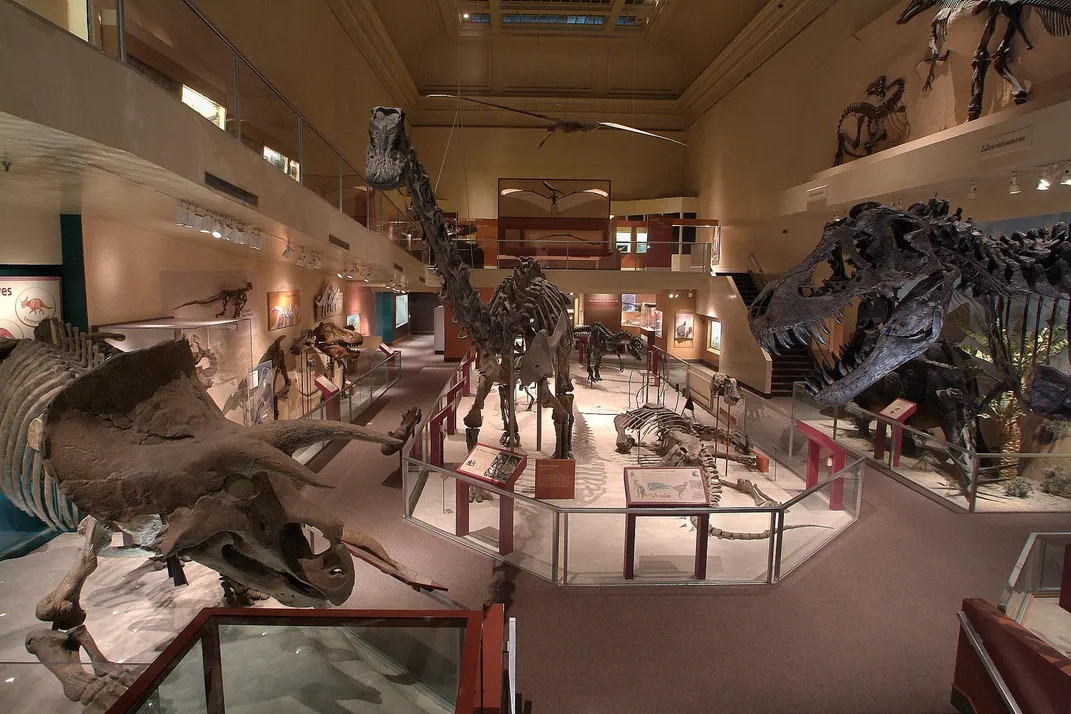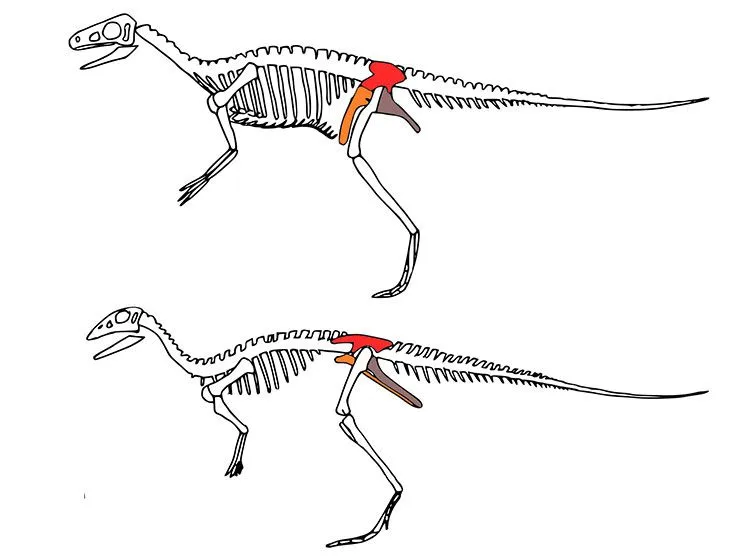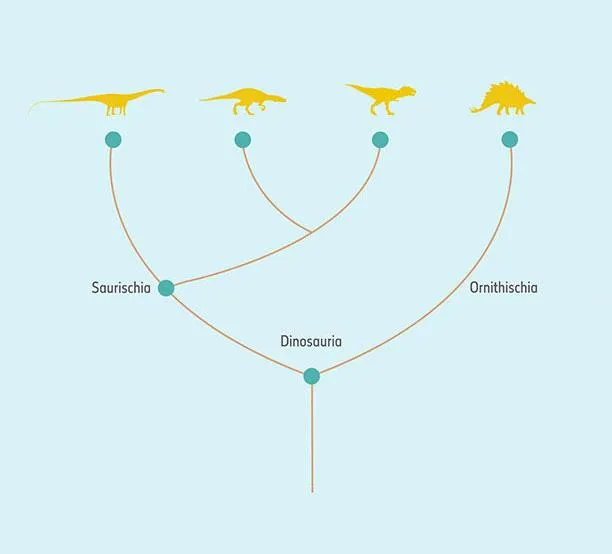What Makes a Dinosaur a Dinosaur?
The question may sound like a “duh,” but it gets to the heart of how we categorize and define nature
/https://tf-cmsv2-smithsonianmag-media.s3.amazonaws.com/filer/6d/97/6d97d1cd-1b61-4dd3-9438-5ce89e88cfb8/fossil-wr.jpg)
Ask any 8-year-old what a dinosaur is, and she’ll eagerly rattle off her favorite of the prehistoric celebrities. And by the time we’re adults, dinosaurs feel utterly familiar; they’re the rockstars of prehistory, more famous and enduring then any Hollywood A-lister. They loom large in our imagination as big, toothy, and, above all, bizarre animals that have been carving out a life for themselves on Earth for the past 235 million years. But what is a dinosaur, really?
To answer that, we need to go back in time (no, not that far). Long before scientists were called scientists, people all over the world had been wondering who left all those ancient bones and footprints. At Flag Point in southern Utah, for example, Native Americans chiseled pictographs of three-toed footprints, inspired by dinosaur tracks in the surrounding Jurassic rock. And even by the time the naturalist William Buckland christened Megalosaurus, the first dinosaur to be named, in 1824, early geologists were in the dark as to what these animals were like. Megalosaurus and other early finds like Iguanodon were envisioned as basically crocodiles and iguanas longer than a city bus.
Enter British paleontologist and biologist Richard Owen, a superstar of 19th century anatomy famous for his cantankerous attitude. As he kept an eye on what his contemporaries were discovering, Owen noticed something strange about some of the petrified reptiles coming out of Europe’s ancient rock. “Many new fossil reptiles had been found in the early 19th century,” Smithsonian’s Curator of Dinosauria Matthew Carrano says, “but it wasn’t clear what they were, or whether they were all related to one another.” Owen set about trying to pinpoint that mysterious relationship.
Owen concluded that Megalosaurus, Iguanodon and a third species called Hylaeosaurus were all united by skeletal similarities in the hip to the exclusion of other saurians of the same time. These features, including five fused vertebrae at a part of the hip called the sacrum, are “peculiar among Reptiles,” Owen wrote in his 1842 report. He argued that this was “sufficient ground for establishing a distinct tribe or sub-order of Saurian Reptiles, for which I would propose the name of Dinosauria”—the terrible lizards.
Since then, discoveries from every continent have filled museums with an increasing number of ever-more-unusual dinosaurs. Yet the more paleontologists find, the stranger and more wonderful these terrible lizards become—and the harder it is to define what makes a dinosaur, a dinosaur.

First of all, dinosaurs are wonderfully diverse. Paleontologists have recognized over 1,000 distinct non-avian species, from tiny, feathery insect hunters to giants that grew to be over 100 feet long and weigh over 70 tons. There were horned dinosaurs, armored dinosaurs, dome-headed dinosaurs, crested dinosaurs, long-necked dinosaurs, sickle-clawed dinosaurs and flesh-ripping dinosaurs. Most lived an entirely terrestrial existence, but some frequently waded into lakes and rivers (recently scientists were flabbergasted by the first known amphibious dinosaur, a swan-like swimmer not dissimilar from a velociraptor). And one lineage flapped and fluttered its way into the air, evolving into the birds that are the only dinosaurs alive today.
These vastly different animals share some key traits: They all laid and hatch from eggs, for example, and all the toothed dinosaurs constantly replaced their dental toolkit throughout their lives. But if we really want to get a handle on what makes a dinosaur a dinosaur, we need to zoom out.
Picking dinosaurs out the reptile family tree—from mighty Tyrannosaurus to a bee hummingbird—requires an evolutionary perspective. Hans-Dieter Sues, the Smithsonian Curator of Vertebrate Paleontology, puts it like this. Dinosauria is a group that contains the most recent common ancestor of birds—like a pigeon walking by on the sidewalk—and the non-avian dinosaur Triceratops, Sues says, including all the descendants of that common ancestor.
There are some tell-tale characteristics of the hind limbs that allow experts to separate dinosaurs from non-dinosaurs going all the way back to the earliest species, Sues says, but the big picture view is that if you take Triceratops in one hand and a pigeon in the other and follow those two back to their last common ancestor, every animal that falls within that group counts as a dinosaur and shares certain traits in common. The two concepts are combined, Carrano says, “dinosaurs are linked by common ancestry, which has given them through inheritance a set of unique features.”
“Dinosaur”, then, isn’t just a popular term for anything scaly and extinct. It’s a scientific term with a strict meaning with a defined membership. Sometimes this creates what might feel like a paradox between the ancient and modern. All birds are dinosaurs, for example, but not all dinosaurs are birds. Given that birds are the only dinosaurs that remain, experts often specify whether they’re talking about non-avian or avian dinosaurs. All the same, a penguin is just as much a terrible lizard as Stegosaurus.

Pop culture, as you’ve probably noticed, doesn’t always play by the rules. In sets of plastic toys, paleo-centric TV shows like DinoRiders, and even the Jurassic Park movies, dinosaurs and non-dinosaurs are often indiscriminately intermingled without much thought to the fact that the word dinosaur doesn’t apply to just anything. The idea that the word dinosaur refers to any suitably reptilian creature, Sues says, “is due to countless children’s books and commercial products that treat any large or bizarre extinct animal as a ‘dinosaur.’”
So how can you, as an armchair or an aspiring paleontologist, know whether that so-called ’saur on the silver screen is a real dino or a wannabe? Fortunately, there are a few giveaways. “A lot of features that unite dinosaurs involve the construction of the hip and thigh regions,” says Smithsonian Peter Buck fellow Adam Pritchard, which gave dinosaurs their upright, pillar-legged posture. “Look at the top of the thigh bone,” or the upper leg in digitally revived dinosaurs of the movies, Pritchard suggests,” and see if it turns inwards to fit inside the socket of the hip.”
Another challenge for the public in deciphering dinos is that geologic time can be hard to squeeze into our heads. “I think it’s quite common in popular thinking to imagine the past as having happened more or less all at once,” Carrano says, which means the further back in time we try to think the more lines get blurred. This means that non-dinosaurs have often been falsely grouped in with the likes of Stegosaurus, even though they lived millions of years apart.
The sail-backed Dimetrodon? That’s a protomammal more closely related to us than dinosaurs. The fish-like ichthyosaurs that swam through the seas? They were one of many reptile lineages that adapted to life in the water during the Mesozoic. And the leathery-winged pterosaurs of the air? Despite being featured in the past three Jurassic Park films, they were cousins of dinosaurs that split off from an earlier ancestor. Dinosaurs are their own discrete group, in other words, joined to all the rest of their family through their common ancestry and identified through the traits of their hips that have been maintained from the Triassic to the present. It might be difficult to think of an emu or quail as a terrible lizard, but you’ll have to take that argument up with the ghost of Richard Owen.

Of course, talking about dinosaurs this way is about as exact as discussing mammals. Mammals—which are typically defined by their tendency to grow fur, give birth to live young and make milk—include everything from humans to hyenas, from shrews to sea whales. Mammals are composed of many branches that have moved around throughout the years, and the same was true for dinosaurs. Paleontologists have spent decades arranging and rearranging these branches, and a study earlier this year reinvigorated a debate over the shape of the dinosaur family tree. “The classification of dinosaurs has undergone countless changes over the years,” Sues says, with the roots of the latest exchange going back to the 19th century.
In 1888 the British paleontologist Harry Govier Seeley argued that Owen’s Dinosauria didn’t make up a natural group, but instead was a mash of what he saw as two very different groups of ancient reptiles. Seeley instead separated these two groups on the basis of their hip shape. There was the Saurischia, which he defined by its roughly lizard-like kind of hip, and included the sauropod and theropod dinosaurs. And then there were the Ornithischia, which had a more bird-like kind of hip, and comprised armored dinosaurs, horned dinosaurs, duckbill dinosaurs and their relatives. (The irony being that we now know “bird-hipped” dinosaurs are not closely related to birds at all. Birds are technically saurischian dinosaurs with highly-modified hips.)
Paleontologists ultimately combined Owen’s and Seeley’s ideas. Today it’s believed that Dinosauria is a real group, anchored through shared traits to common ancestry to the exclusion of other animals. But the saurischians and ornithischians are the two main branches with more specific lineages arrayed along them. Other ideas came and went, but this vision of the dinosaur family tree stayed stable. Then, early in 2017, a study by paleontologist Matthew Baron and colleagues shook things up.
Instead of finding the traditional arrangement, the new analysis by Baron and colleagues came up with something different. Dinosaurs remained as a natural group, but theropod dinosaurs came out as close relatives of ornithischians—normally positioned on the other side of the family tree—and sauropod dinosaurs showed up as relatives of an enigmatic group of early carnivorous dinosaurs called herrerasaurids. The researchers decided to call the theropod-ornithischian group Ornithoscelida (a term coined by 19th century naturalist Thomas Henry Huxley) and kept Saurischia for the other group.
But a single new paper doesn’t make a consensus. Months later, a different group of paleontologists upheld the traditional arrangement in a rebuttal, to which followed a rebuttal to the rebuttal. For the moment, Sues says, “most dinosaur experts are not swayed by the novel hypothesis, but it does serve a useful purpose because it will stimulate more in-depth analysis, especially of early dinosaurs.”
If all this systematic shuffling has left you in a tizzy, don’t fret. A new fossil or analysis can sow more confusion that understanding upon announcement, says Pritchard. But that’s no reason to despair. This is just how science works: Just as dinosaurs evolved and changed, so does the science, to incorporate new evidence and theories. Relationships are not ‘established’ but must always remain hypotheses,” Sues says, which “stand or fall as evidence is accrued.” “That seems to be normal for nature,” Pritchard adds. “It is always much more complicated and unexpected than what scientists predict.”
/https://tf-cmsv2-smithsonianmag-media.s3.amazonaws.com/accounts/headshot/RileyBlack.png)
/https://tf-cmsv2-smithsonianmag-media.s3.amazonaws.com/accounts/headshot/RileyBlack.png)